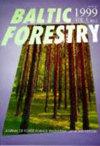乌拉尔地区森林的碳储量
IF 0.6
4区 农林科学
Q3 FORESTRY
引用次数: 0
摘要
本文研究了乌拉尔地区森林基金森林中的碳储量。森林生物量中的碳沉积,平均、年均和年碳吸收量按年龄组和优势物种进行评估。森林的年均破坏率是根据森林火灾和被烧毁地区的面积估计的。根据该方法估算了连续伐木后生物质池中的碳损失俄罗斯联邦自然资源部制定的“关于批准温室气体排放量计算指南”。碳储存指标是根据所有年龄组的针叶林、硬叶林和软叶林的红木计算的。显示了2007-2018年期间碳储存的变化。研究地区巴什科尔托斯坦共和国的森林被发现每年吸收361890万吨碳。在针叶林中,樟子松森林的碳积累量最大,为5838.43万吨。碳吸收量与其预算之间的差额为31.244万吨/年。在共和国占主导地位的软叶林分积累了最大的总碳储量,为195900.2万吨。然而,它们的平均碳储量水平低于针叶林和硬叶林。保持二氧化碳吸收水平是共和国林业部门的一项战略任务,补偿性重新造林是一个解决方案。关键词:吸收;碳针叶林;落叶林;存储木材采伐本文章由计算机程序翻译,如有差异,请以英文原文为准。
Carbon stocks in the forests of the Ural Region
This paper examines carbon stocks in the forests of the Ural region forest fund. Carbon deposition in forest biomass, the average, average annual and annual carbon absorption were assessed by age groups and dominant species. The average annual rates of forest destruction were estimated depending on the territory of forest fires and burnt areas. Carbon losses in the biomass pool after continuous logging were estimated according to the methodology "On approving guidance to calculate greenhouse gas emissions” developed by the Ministry of Natural Resources of the Russian Federation. Carbon storage indicators were calculated from the groundwood of coniferous, hard-leaved and soft-leaved forests for all age groups. Changes in carbon stocks are shown for the period 2007-2018. The forests of the study area, the Republic of Bashkortostan, were found to sink carbon in 3,618.9 thousand tons/year. Pinus sylvestris L. forests accumulate the largest amount of carbon, 58,384.3 thousand tons, among coniferous forests. The difference between carbon absorption and its budget was 3,124.4 thousand tons/year. Soft-leaved stands that dominate in the republic accumulate the largest total carbon stock being 195,900.2 thousand tons. However, their average level of carbon stock is lower than that of coniferous and hard-leaved forests. Maintaining the level of carbon dioxide uptake is a strategic task of the republic's forestry sector, with compensatory reforestation being one solution. Keywords: absorption; carbon; coniferous forests; deciduous forests; storage; wood harvesting
求助全文
通过发布文献求助,成功后即可免费获取论文全文。
去求助
来源期刊

Baltic Forestry
农林科学-林学
CiteScore
1.60
自引率
0.00%
发文量
23
审稿时长
>12 weeks
期刊介绍:
The journal welcomes the original articles as well as short reports, review papers on forestry and forest science throughout the Baltic Sea region and elsewhere in the area of boreal and temperate forests. The Baltic Sea region is rather unique through its intrinsic environment and distinguished geographical and social conditions. A temperate climate, transitional and continental, has influenced formation of the mixed coniferous and deciduous stands of high productivity and biological diversity. The forest science has been affected by the ideas from both the East and West.
In 1995, Forest Research Institutes and Universities from Estonia, Latvia and Lithuania
joined their efforts to publish BALTIC FORESTRY.
 求助内容:
求助内容: 应助结果提醒方式:
应助结果提醒方式:


